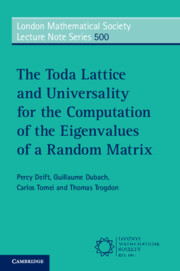
- Coming soon
- Publisher:
- Cambridge University Press
- Expected online publication date:
- November 2025
- Print publication year:
- 2025
- Online ISBN:
- 9781009664332

Written by leaders in the field, this text showcases some of the remarkable properties of the finite Toda lattice and applies this theory to establish universality for the associated Toda eigenvalue algorithm for random Hermitian matrices. The authors expand on a 2019 course at the Courant Institute to provide a comprehensive introduction to the area, including previously unpublished results. They begin with a brief overview of Hamiltonian mechanics and symplectic manifolds, then derive the action-angle variables for the Toda lattice on symmetric matrices. This text is one of the first to feature a new perspective on the Toda lattice that does not use the Hamiltonian structure to analyze its dynamics. Finally, portions of the above theory are combined with random matrix theory to establish universality for the runtime of the associated Toda algorithm for eigenvalue computation.
 Loading metrics...
Loading metrics...
* Views captured on Cambridge Core between #date#. This data will be updated every 24 hours.
Usage data cannot currently be displayed.
The PDF of this book complies with version 2.2 of the Web Content Accessibility Guidelines (WCAG), offering more comprehensive accessibility measures for a broad range of users and meets the basic (A) level of WCAG compliance, addressing essential accessibility barriers.
Allows you to navigate directly to chapters, sections, or non‐text items through a linked table of contents, reducing the need for extensive scrolling.
Provides an interactive index, letting you go straight to where a term or subject appears in the text without manual searching.
You will encounter all content (including footnotes, captions, etc.) in a clear, sequential flow, making it easier to follow with assistive tools like screen readers.
You get concise descriptions (for images, charts, or media clips), ensuring you do not miss crucial information when visual or audio elements are not accessible.